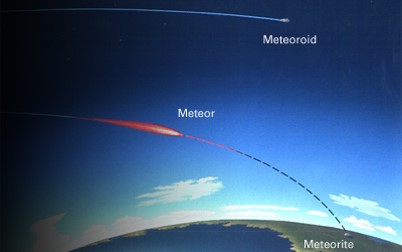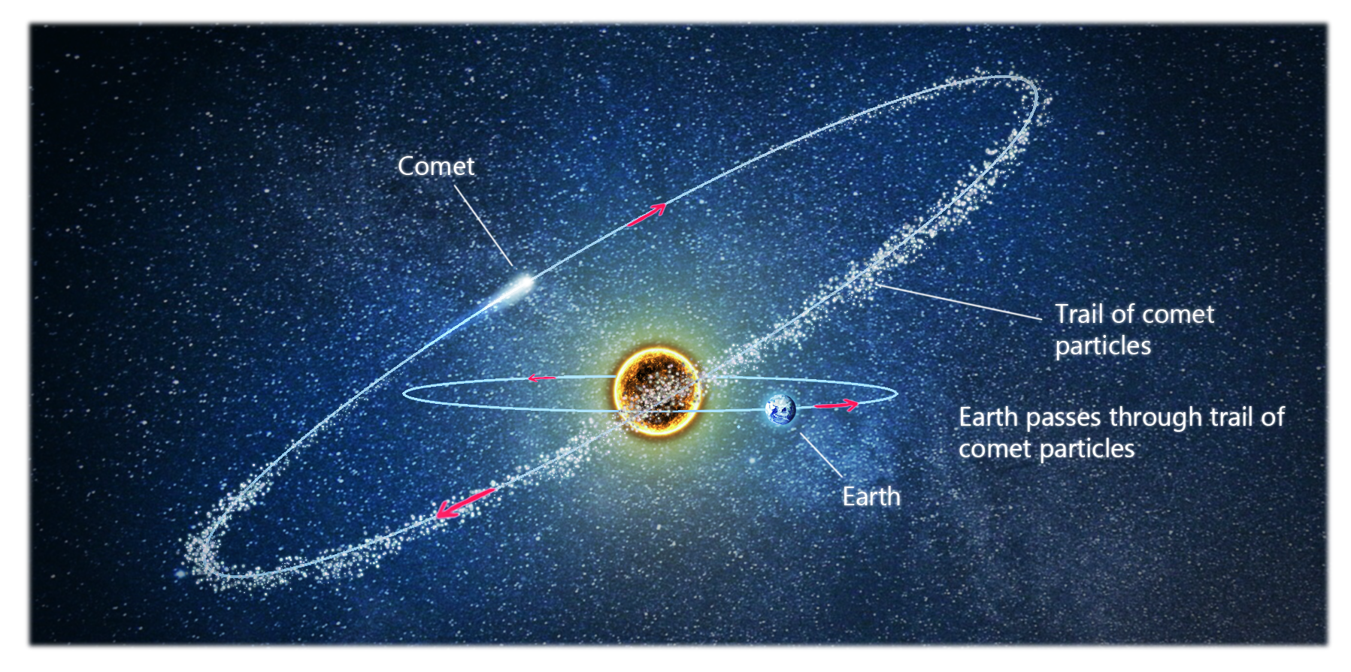Generalities on meteors
A meteoroid is any solid particle moving in the Solar System with a size between 30 microns and 1m. Beyond these limits, we talk about either nano-dust particles (<30 microns) or asteroids (>1m). The visible phenomenon due to the entrance of a meteoroid into the Earth's atmosphere is called a meteor (or more commonly a shooting star). The vast majority of meteroids are completely burnt at altitudes between 90 and 110 km where they form permanent layers of metallic species such as Iron, Nickel, Sodium. For the largest meteoroids, a part of the object might survive the passing of the atmosphere (that also strongly depends on its trajectory and initial speed). If a small remnant of the meteoroid reaches the ground, it is called a meteorite.

Meteors may occur at specific times in the year, the so-called meteor showers (such as e.g. the Perseids or the Geminids), or more or less randomly at any time, the so-called sporadic meteors. Meteor showers happen when the Earth passes through a dust of particles released along the trajectory of a comet, every time the latter approaches its perihelion (closest point to the Sun along the orbit) .

When a tiny meteoroid (< 10-3g) enters the atmosphere, it does not produce enough light to be dectected from the ground (even with sensitive cameras), but it collides with the molecules/atoms of the upper atmosphere (roughly 80-120 km) and remove one or more electrons from them (ionization). This creates an electron trail along the meteor path on which a radio signal can be reflected and detected by a radio receiver under some geometrical conditions (see below). A meteor detected by this way is called a radio meteor or a meteor echo.
Forward Scattering radio observations
The main principle of forward scattering is illustrated in the figure below. A radio receiver is tuned on the frequency emitted by a transmitter. Direct transmission is impossible because of the curvature of the Earth. When a meteor enters the atmosphere, its trail (illustrated by the arrow in yellow) may reflect temporiraly the radio signal from the transmitter to the receiver. The signal recorded at the receiving station is called a meteor echo. Its duration depends on the lifetime of the trail. The electrons in the trail tend to scatter quickly in the ambient neutral atmosphere. The duration of most meteor echoes is of a fraction of a second but in some rarer cases, it can reach a few seconds up to a few tens of seconds.

An important characteristic of meteor observation by forward scattering is that the reflection is specular. It means that the meteor trail acts like a long mirror on which reflection occurs only at one location (specular point). An optical analogy is shown below where the transmitter is a light bulb, the receiver is our own eyes and the meteor electron trail acts as a mirror. The consequence is that data computed from the observations at one receiving station only apply to this particular part of the trail.

The position of this specular reflection point only depends on the geometry, namely the positions of the transmitter T and receiver R, and the meteor path L. It can be shown that the position of the specular reflection point p is the point along L that is tangential to an ellipsoid which has R and T as focii. At the point p, the radio wave travels the smallest distance between T, L and R (see figure a) below from Wislez & Verbeeck, 2006).
This has important consequence : for one fixed configuration T-R, not all meteors can be detected at the receiving station. Indeed, p must be located within the so-called meteor zone (in grey in the figure below) which is approximately located between 80 and 110 km altitude.
The upper limit is linked to the fact that the density of the atmosphere at higher altitude quickly drops and therefore not enough ionization can be created by the meteoroid to reflect enough power. The lower limit is mainly due to the fact that most meteors are fully vaporized before reaching such low altitudes. In the case b) below, the reflection point is located too low along L and is never created. In the case c), it is located at too high altitude. In both cases, the meteor echo cannot be detected at R.

Profiles of the meteor echoes
The features of the receiving signal essentially depend on the electron density in the meteor trail. Two cases are mainly discussed: the underdense trails, which correspond to very low electron densities, and the overdense trails, which correspond to very high electron densities.
Underdense meteors
Underdense meteors correspond to very small meteoroids (typically a fraction of a mm in diameter). They are the most frequent ones observed by the BRAMS network since these tiny particles are by far the most numerous. Underdense meteor echoes are very short-libed (a few tenths of second) and their typical profile is illustrated in the figure below, on which the horizontal x-axis represents time and the vertical y-axis represents the power recorded for this meteor echo.
It consists in a very rapid rise to a maximum, which corresponds to the time when the specular reflection point is created. It is then immediately followed by an exponential decay which corresponds to the phase where electrons tend to scatter in the ambient neutral atmosphere and the trail eventually disappears. The signal returns then to the background level noise of the receiving station. The duration of a meteor echo is measured as the exponential decay time of the signal.

Overdense meteors
Overdense meteors are rarer and they correspond to bigger meteoroids. These echoes can last between a few seconds up to a few tens of seconds. A typical signal is shown in the figure below.

Benefits of Radio observations
Radio observations can be carried out 24/7, independently of the weather conditions and during daylight. This has led to discover diurnal meteor showers such as e.g. the zeta Perseids in June. Only during strong thunderstorms with a lot of lightnings near the receiving station, the data can become useless due to too many broad-band strong interference.
Faint meteors cannot be detected by visual observations because they do not emit enough light. Radio observations are therefore sensitive to smaller meteoroids and to a larger mass range than visual observations. The two methods of observations are complementary.
Additional sources of information
Videos about radio observations of meteors and the BRAMS network prepared for the RMZ
- General information on meteors
- Sporadic meteors vs meteor showers
- Radio observations of meteors
- Specular reflection
- The BRAMS network
External links






